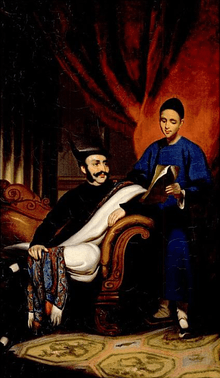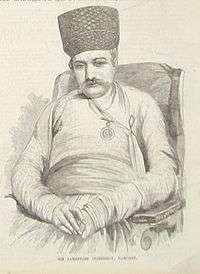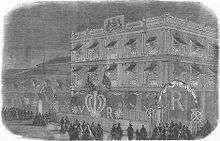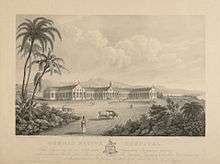Jamsetjee Jejeebhoy
| Sir Jamsetjee Jejeebhoy, Bt | |
|---|---|
 Jejeebhoy and his Chinese secretary (portrait by George Chinnery) | |
| Born |
15 July 1783 Bombay, India |
| Died |
14 April 1859 (aged 75) Bombay, India |
| Occupation | Merchandiser, business magnate |
Sir Jamsetjee Jejeebhoy, 1st Baronet Jejeebhoy of Bombay, CMG (15 July 1783 – 14 April 1859[1]), also spelt Jeejeebhoy or Jeejebhoy, was a Parsi-Indian merchant and philanthropist. He is more historically notable for making a huge fortune in cotton and opium trade to China.[2][3][4] He was considered Bombay's most worthy son.
Early life and business career
Jejeebhoy was born in Bombay (now Mumbai) in 1783, the son of Merwanjee Mackjee Jejeebhoy and Jeevibai Cowasjee Jejeebhoy. His father was a textile merchant from Olpad, Gujarat, who migrated to Bombay in the 1770s.[5] Both of Jeejeebhoy's parents died in 1799, leaving the 16-year-old under the tutelage of his maternal uncle, Framjee Nasserwanjee Battliwala. At the age of sixteen, having had little formal education,[6] he made his first visit to Calcutta and then began his first voyage to China to trade in cotton and opium.[7]
Jejeebhoy's second voyage to China was made in a ship of the East India Company's fleet. Under the command of Sir Nathaniel Dance, this ship drove off a French squadron under Rear-Admiral Charles-Alexandre Léon Durand Linois[6] in the Battle of Pulo Aura.
On Jejeebhoy's fourth voyage to China, the Indiaman in which he sailed was forced to surrender to the French, by whom he was carried as a prisoner to the Cape of Good Hope, then a neutral Dutch possession.[6] After much delay and great difficulty, Jejeebhoy made his way to Calcutta in a Danish ship.[6] Undaunted, Jejeebhoy undertook another voyage to China which was more successful than any of his previous journeys.[6]
By this time Jejeebhoy had fairly established his reputation as an enterprising merchant possessed of considerable wealth.[6] In 1803, he married his maternal uncle's daughter Avabai (d.1870) and settled in Bombay, where he directed his commercial operations on an extended scale.[6] Around this time, he changed his name from "Jamshed" to "Jamsetjee" to sound similar to names of the Gujarati community. By the age of 40, he had made over two crore rupees, a staggering sum in those days. Further riches came to him from cotton trade during the Napoleonic Wars. He bought his own fleet of ships. Said Lord Elphinstone, then Governor of Bombay, of Jamsetjee Jeejeebhoy, ‘By strict integrity, by industry and punctuality in all his commercial transactions, he contributed to raise the character of the Bombay merchant in the most distant markets.’ [8]
In 1814, his co-operation with the British East India company had yielded him sufficient profits to purchase his first ship, the Good Success, and he gradually added another six ships to this, usually carrying primarily opium and a little cotton to China.[9] By 1836, Jejeebhoy's firm was large enough to employ his three sons and other relatives, and he had amassed what at that period of Indian mercantile history was regarded as fabulous wealth.[6]
Jejeebhoy was known by the nickname "Mr. Bottlewalla". "Walla" meant "fellow", and Jejeebhoy's business interests included the manufacture and sale of bottles on the basis of his uncle's business. Jejeebhoy and his family would often sign letters and checks using the name "Battliwala", and were known by that name in business and society, but he did not choose this assumed surname when it came to the baronetcy.
In 1818, he formed the business, trading and shipping firm "Jamsetjee Jejeebhoy & Co." with two other associates Motichund Amichund and Mahomed Ali Rogay as Jejeebhoy’s business associates. He was later joined by a Goan Rogeria de Faria. His voyages to China resulted in a long trading partnership with the Canton based company Jardine Matheson & Co. The connection with Jeejeebhoy was instrumental as Jardine and Matheson built up their great firm, continuing the profitable and amiable association with the Parsi entrepreneur. Jeejeebhoy long continued as one of the close associates who served as underwriters to Jardine, Matheson and Company. A tribute to their connection exists even today in a portrait of Jeejeebhoy which hangs in Jardine’s Hong Kong office.[10] He was seen as the chief representative of the Indian community in Bombay by the British Imperial authorities.[11]
Philanthropy




An essentially self-made man, having experienced the miseries of poverty in early life, Jejeebhoy developed great sympathy for his poorer countrymen.[6] In his later life he was occupied with alleviating human distress in all its forms. Parsi and Christian, Hindu and Muslim, were alike the objects of his beneficence. Hospitals, schools, homes of charity and pension funds throughout India (particularly in Bombay, Navsari, Surat, and Poona) were created or endowed by Jejeebhoy, and he financed the construction of many public works such as wells, reservoirs, bridges, and causeways.[6] By the time of his death in 1859, he was estimated to have donated over £230,000 to charity.[6] His philanthropic endeavours began in earnest in 1822, when he personally remitted the debts of all the poor in Bombay's civil jail.[12] Some of Jejeebhoy's notable charitable works include:
- Mahim Causeway: The British Government had refused to build a causeway to connect the island of Mahim to Bandra. Jejeebhoy's wife Avabai Jamsetjee Jeejeebhoy spent ₨.155,800 to finance its construction, after whom it was named. The work began in 1841 and is believed to have been completed four years later.
- Sir J. J. Hospital
- Jejeebhoy donated to at least 126 notable public charities, including the Sir Jamsetjee Jejeebhoy School of Art, the Sir J. J. College of Architecture,[13] the Sir J.J. Institute of Applied Art and the Seth R.J.J. High School. He also endowed charities dedicated to helping his fellow Parsis and created the "Sir Jamsetjee Jeejebhoy Parsi Benevolent Fund".
- The Dr. Bhau Daji Lad Museum, formerly The Victoria and Albert Museum, which was designed by a London architect was built with the patronage of many wealthy Indian businessmen and philanthropists like Jejeebhoy, David Sassoon and Jaganath Shunkerseth.
- Construction of Charni Road and relief to cattle. Between 1822 and 1838, cattle from the congested fort area used to graze freely at the Camp Maidan (now called Azad Maidan), an open ground opposite the Victoria Terminus. In 1838, the British rulers introduced a 'grazing fee' which several cattle-owners could not afford. Therefore, Sir Jamshedji Jeejeebhoy spent Rs. 20,000 from his own purse for purchasing some grasslands near the seafront at Thakurdwar and saw that the starving cattle grazed without a fee in that area. In time the area became to be known as "Charni" meaning grazing. When a railway station on the BB&CI railway was constructed there it was called Charni Road.
- He spent Rs. 1,45,403 to set up the Sir J. J. Dharamshala at Bellasis Road, and till today innumerable old and destitute people receive free food, clothing, shelter and medicines. All their needs for the past 150 years, irrespective of caste, creed or religion, have been looked after by the Dharamshala, the first free home for the elderly in Asia.[8]
- Whether it was the famine of Ireland (1822), the floods in France (1856) or the fire, which ravaged both Bombay (1803) and Surat (1837), this beacon of altruism gave graciously to one and all without discriminating on the basis of caste or creed.
Baronetcy
Jejeebhoy's services were first recognised by the British Empire in 1842 by the bestowal of a knighthood and in 1858 by the award of a baronetcy. These were the very first distinctions of their kind conferred by Queen Victoria upon a British subject in India.[6]
On Jejeebhoy's death in 1859, his Baronetcy was inherited by his eldest son Cursetjee Jejeebhoy, who, by a special Act of the Viceroy's Council in pursuance of a provision in the letters-patent, took the name of Sir Jamsetjee Jejeebhoy as second baronet.[6]
Jejeebhoy and the Parsi community
From 1838 onward, the Bombay Parsi Panchayat came to be increasingly disregarded as the instrument for regulating the affairs of members of the community that resided in the Bombay Presidency. Amidst calls for dissolution of the (then) 110-year-old institution for nepotism and fiscal mismanagement (it would eventually be reestablished as administrator of community property), the community gradually came to depend on prominent individuals not connected to the panchayat and its improprieties. This was especially true for Jejeebhoy, thanks to his wealth and charitable works and the recognition afforded him by the British authorities due to his baronetcy.
An Advocate of Non-Violence
In 1855, under royal patronage, the Patriotic Fund was launched to aid the wounded soldiers and widows of those who had died in the Russo-Turkish war. Jamsetjee donated Rs. 5,000/- for this cause. But some remarks from his speech on this occasion are most significant:
“Of none of the great evils which afflict our race do we form such inadequate conceptions as of the evils of war. War is exhibited to us in the dazzling dress of poetry, fiction, and history, where its horrors are carefully concealed beneath its gaudy trappings; or we see, perhaps, its plumes and epaulettes, and harlequin finery, we hear of the magnificence of the apparatus, the bravery of the troops, the glory of the victors, but the story of the wholesale miseries and wretchedness and wrongs which follow in its train is untold…What nation is not groaning under war-debts, the greatest of national burdens! Had the inconceivable sum wasted in the work of human butchery been applied to promote individual comfort and national prosperity, the world would not now be so far behind as it is in its career of progress…Our duty to relieve the sufferers in this great war would have remained the same whether the war had been a just one or not; but, considering the nature and objects of this war, we extend this relief now more as a privilege than as a duty…To the call of our gracious Sovereign, and to the call of humanity, the Parsis, my lord, will cordially respond”.
His non-violent attitude or positively put, his loving kindness extended also to the animal kingdom. His benign and compassionate nature would not allow any form of cruelty towards animals. The East India Company introduced a rule “for the annual destruction of dogs in Bombay island, and a considerable number were from time to time destroyed, in spite of frequent petitions from the public”. This mass dog killing led to a serious riot. To alleviate this suffering, Jamsetjee with others founded Panjrapole on October 18, 1834.[14]
Bibliography
- B. K. Karanjia (1998). Give me a Bombay merchant anytime!: the life of Sir Jamsetjee Jejeebhoy, Bt., 1783–1859. University of Mumbai.
References
- ↑ http://www.leighrayment.com/baronetage/baronetsJ.htm
- ↑ Palsetia, Jesse S (2001), The Parsis of India the Parsis of India: Preservation of Identity in Bombay City Preservation of Identity in Bombay City By., Leiden, Netherlands: Brill Academic Publishers, p. 55, ISBN 9004121145
- ↑ Prakash, Gyan (2001), Mumbai Fables, New Delhi: Harpercollins, p. 00, ISBN 9350291665
- ↑ Farooqui, Amar (2001), Smuggling as Subversion: Colonialism, Indian Merchants, and the Politics of Opium, 1790-1843, New Delhi: Lexington Books, p. 210, ISBN 0739108867
- ↑ Jansetjee Jejeebhoy. Encyclopedia Iranica. Retrieved 16 August 2015.
- 1 2 3 4 5 6 7 8 9 10 11 12 13

- ↑ Rungta, Shyam, The Rise of Business Corporations in India, 1851–1900, New Delhi: Cambridge University Press, p. 57, ISBN 0-521-07354-5
- 1 2 "Yatha Ahu Vairyo Mohalla". 30 January 2012.
- ↑ Bulley, Anne (16 December 2013). The Bombay Country Ships 1790-1833. Routledge. ISBN 1136833137.
- ↑ "Jamsetjee Jeejeebhoy: China, William Jardine, the Celestial, and other HK connections".
- ↑ Karaka, D.F. (1884). History of the Parsis. London.
|access-date=requires|url=(help) - ↑ "Jamsetjee Jejeebhoy". www.robinsonlibrary.com.
- ↑ "Sir JJ College Of Architecture, Bombay– Home". Sir JJ College of Architecture. Accessed 23 May 2010.
- ↑ "History | Bombay Panjrapole". www.bombaypanjrapole.org.in. Retrieved 2018-05-04.
External links
- Brief profile of Sir J.J.
- Brief biography of Sir J.J.
- Homi Dhalla, "Sir Jamsetjee Jejeebhoy, Lesser Known Facts about his Multidimensional Personality", homidhalla.com
- Sir J.J. on David Philpson's site
- Parsee settlers in Bombay
| Baronetage of the United Kingdom | ||
|---|---|---|
| Preceded by New creation |
Baronet (of Bombay) 1857–1859 |
Succeeded by Cursetjee Jejeebhoy |